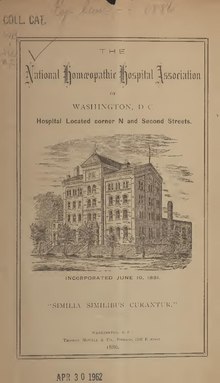National Homeopathic Hospital
"[1] According to Dr. Samuel Clagett Busey, the adoption of this clause against the protest and over the votes of the medical members present, aroused the opposition and open hostility of many of its most conspicuous supporters among the profession at large and threatened for a time not only the success of the enterprise, but, what was even worse, to effect its transfer to the homeopathists."
As duplication of agencies involved additional cost in the way of overhead charges, it was unfortunate that the proposed union with Garfield Memorial Hospital was not accomplished.
[1] The friends of the National Homeopathic Hospital, having received in the meantime both money and pledges from private sources, appealed to United States Congress in 1884 for recognition of a homeopathic hospital among the charities in the District of Columbia and secured an appropriation of US$15,000 for the purchase or erection of a building.
[1] In November 1888, A. S. Pratt, President Board of Trustees, made a statement to Congress with details of the receipts and expenditures and a report of the operations of the National Homeopathic Hospital Association for the fiscal year ending June 30, 1888.
Further, the board of trustees of the association instructed him to provide an estimate of the amount necessary to maintain the hospital for the fiscal year ending June 30, 1890.
The business and object of the Society would be:[3]... to continue the beneficial work heretofore inaugurated and carried on by the Society incorporated by certificate dated June 10, 1881, under the name of the National Homeopathic Hospital Association of Washington, District of Columbia, and to this end to maintain a Homeopathic Hospital in the District of Columbia, in which the medical staff shall be composed of Homeopathic physicians only, but in which patients may be treated by any reputable physician of any recognized school of medicine, under regulations to be provided by the Board of Trustees; in which proper care and treatment may be given to lying-in women who may wish to be under homeopathic treatment; to which persons temporarily residing in the city may resort in case of sickness; to which accident cases, or persons suddenly taken sick in the street may be carried for temporary treatment; in which nurses may be instructed and clinical instruction given to students of medicine; in connection with which there may be a dispensary for the treatment of the poor homeopathically and to do such other things as may be legitimate and necessary to the efficient execution of the abovenamed purposes.A training school for nurses was connected with the hospital.
They were encouraged to visit the capital, the libraries, the museums, the art gallery and other public buildings of civic and historical interest, so that their three years in Washington would make them, not only good nurses, but broader and more cultured women.
As the school was non-sectarian, there were no religious services connected with it, but all pupils were expected to attend the place of worship they prefer, once on Sunday.





